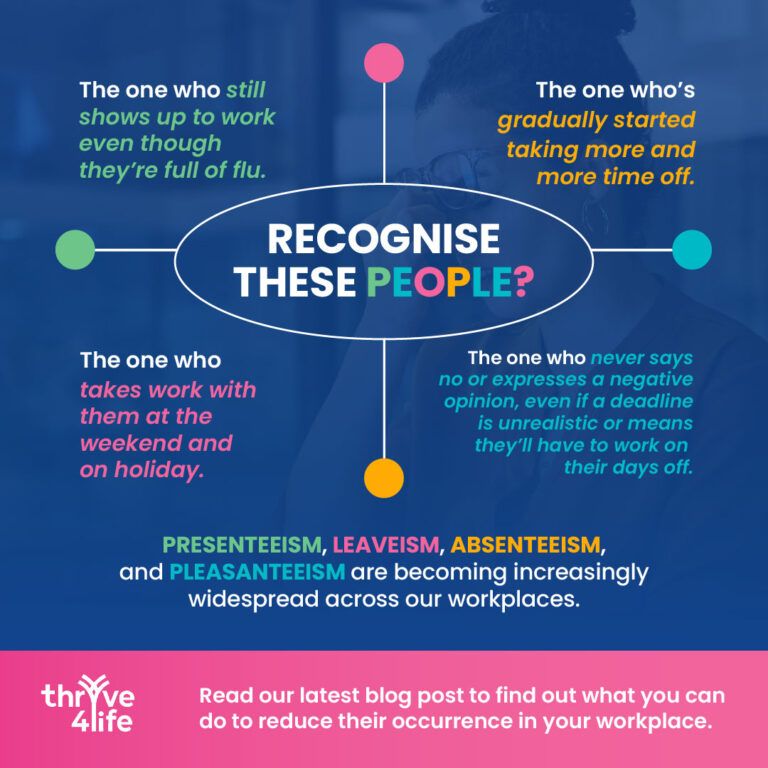A healthy working culture should be the cornerstone of any workplace – after all, there’s little more important than your employees feeling safe and happy while at work. But it can be hard to detect when your team aren’t feeling themselves or feeling 100% happy in their jobs. Before you know it, you’re having to deal with the “ism”s of the workplace: presenteeism, leaveism, absenteeism, and pleasanteeism. Not quite sure what they mean? You’re not the only one, yet their prevalence is on the rise and can be a tell-all indicator of overall levels of well-being and productivity in the workplace and what’s putting these at risk.
The Background
Problems relating to stress and depression account for almost half of all working days lost in the UK. What’s more? Employers pay out £9 billion in sick pay as a result every single year. But presenteeism and its siblings aren’t just a numbers issue – they’re often reflective of poor workplace health and wellbeing. Indeed, these attendance management problems are becoming increasingly frequent in our workplaces, and understanding what they are and why they happen is the first step towards resolving them. Here’s your guide to spotting them and preventing employees from resorting to them.
Example Characters
Do any of these characters feel familiar?
- The one who still shows up to work even though they’re so under the weather they can’t possibly be productive.
- The stress-harbourer who takes work with them on the weekends and on holiday.
- The one who refuses to take annual leave.
- The one who finds it impossible to ask for help so buries themselves beneath a high workload instead.
- The one who can’t say no so ends up committing themselves to the tightest deadlines and working through their days off.

The Terminology
There are a lot of “ism”s to cover: read on for a breakdown of each and more guidance on spotting them in their early stages.
Presenteeism
Presenteeism is “the practice of staying at work longer than usual or when you are ill, to show that you work hard and are important to your employer” – or because you’re so pushed to complete your workload that you feel like there’s no other way to do your job. It has been estimated that presenteeism’s negative impact on productivity is 12 times higher than that of absenteeism. People may practice presenteeism to show that they are on top of all their work and working to the best of their abilities when in actuality, they’re on a fast-track to burnout. Since the pandemic, the number of hours worked around the world has actually gone up, not down. This is mainly because our increasingly digital world allows people to be constantly connected to work – we can pick up the phone at any time and reply to an email from across the world. This often-manic need to show how engaged and committed we are or respond to the pressures our colleagues put on us is increasing levels of presenteeism.
What to Look Out For
- Making common or easily avoidable mistakes.
- Poor quality of work – people who seem to prefer quantity over quality.
- Poor time-keeping: arriving late and leaving early, especially when ill.
- Or working stupidly long hours but seemingly getting nothing done.
- Working while obviously unwell.
- Looking or acting tired and exhausted.
- Erratic behaviour and low mood: watch out for deteriorating relationships with colleagues.
Leaveism
Employees engage in leaveism when they use allocated time off (e.g., annual leave) as sick leave, take work home that they didn’t complete during their working hours, or work while on holiday to catch up. It’s pretty similar to presenteeism, but the key difference is that these people are always switched on to work. In 2020, a survey found that a grand 51% of UK employees were working outside of their contracted hours. There’s a fine line between working hard and working too hard – and leaveism very much oversteps that boundary.
What to Look Out For
- A chronic online presence: employees are rarely logged off and are always available.
- Reluctance to use annual leave.
- When they do use annual leave, a lack of trust or concern about handing over ‘their’ projects to their colleagues.
- Cancelling leave last minute for an event or project at work.
- Taking work with them at the weekend or on holiday.
Pleasanteeism means concealing any stress, low mood, or issues employees may be experiencing with pleasantries instead. In February 2022, a survey found that 75% of employees admit to putting on a brave face at work, increasing from 51% in May 2021. While it’s important to be professional and positive at work, a workplace that encourages unhealthy levels of productivity and surface-level friendships may lead employees to resort to pleasanteeism – pretending to be happy about things even when you’re feeling totally the opposite.
Employees seeming happy all the time may not look like a bad thing at all, but a lot can hide behind a smile. This makes pleasanteeism very hard to spot.
What to Look Out For
- A workplace that pushes through all difficulties isn’t likely to promote healthy discussions about wellbeing and mental health – make sure these conversations are happening.
- A little bit too chipper: don’t ignore employees who seem to always put on a brave face, and encourage communication about any issues rather than avoiding discussing them for fear of rebuff or because they simply don’t want to get into it.
Research by the CIPD found that only 36% of employees actually take time off when unwell, according to a study of staff in 1,000+ companies in the private and public sector.
Mental Health Skills Development
Mental Health First Aid teams have an indispensable role in the workplace. Thrive4Life’s Mental Health First Aid course and subsequent Mental Health Skills Development workshop are MHFA England-accredited courses which can equip members of your team with Mental Health First Aid qualifications. Our courses are constantly being updated, with current topics covering everything from the impacts of COVID-19 on employee wellbeing to the challenges of working remotely.
What are the Risks the “ism”s could have for Your Workplace?
If instances of presenteeism, pleasanteeism, leaveism, and absenteeism get out of hand, you could be facing significant HR issues. These include employee stress and burnout; the development, spread, and worsening of mental illnesses; low morale; and an increase in resignations.
Taking Action: 5 Strategies to Implement
According to a recent report, only 49% of employees feel comfortable talking to their manager about mental health issues. The key is to not only address these potential problems but also use dedicated resources and time to solve them.
1. Create a clear absence policy. It’s completely up to you to decide what counts as a reasonable absence – just make sure your employees are familiar with it and know how to report an absence when necessary. Overly rigid attendance policies encourage presenteeism and leaveism.
2. Monitor your employee’s workload so that overworking isn’t an option. Try holding one-on-one meetings with your staff to build good employee relations and tackle issues head-on. These meetings can be used to talk about managing workloads as well as possible problems like absenteeism.
3. Be a role model for your employees by not displaying these traits. When employees see their management taking their work home with them or not taking sick days when they’re clearly ill, they are more likely to replicate it as they’ll think that you also have this expectation for them.
4. Develop an employee wellbeing strategy that works. A recent report found that simply having a wellbeing strategy didn’t reduce levels of presenteeism, but organisations with senior managers who actively acknowledged and were aware of the importance of high levels of workplace wellbeing were more likely to reduce the risks that can lead to presenteeism and other attendance issues. Stuck for ideas? Check out how you can subscribe your team to access to Thrive4Life’s Health & Wellbeing Discovery Hub, which is designed to increase employee interest and encourage proactivity in personal health and wellbeing.
5. Consider flexible office/work-from-home options. Of course, this won’t be possible for every organisation or industry. However, if your staff can work from home, this is a great way for them to build their work around their other responsibilities, such as appointments, childcare, etc, helping them focus and feel more productive when they’re at work.
Tackling presenteeism, absenteeism, pleasanteeism, and leaveism is is a great start to improving employee wellbeing in the long term. It’s about designating space for rest and recovery, improving productivity and performance, emphasising outcomes rather than hours worked, and finally, but most importantly, nurturing happier employees who work hard so that they can also enjoy their life outside of their jobs.
Further Reading
The ability to switch off from work mode doesn’t come naturally to everybody. Check out our work/life balance series, which tackles the challenges of work stress and maintaining calm.
Annual leave is something we should all be using to the full! So, take that holiday and discover why you should be prompting PTO for your employees here.










